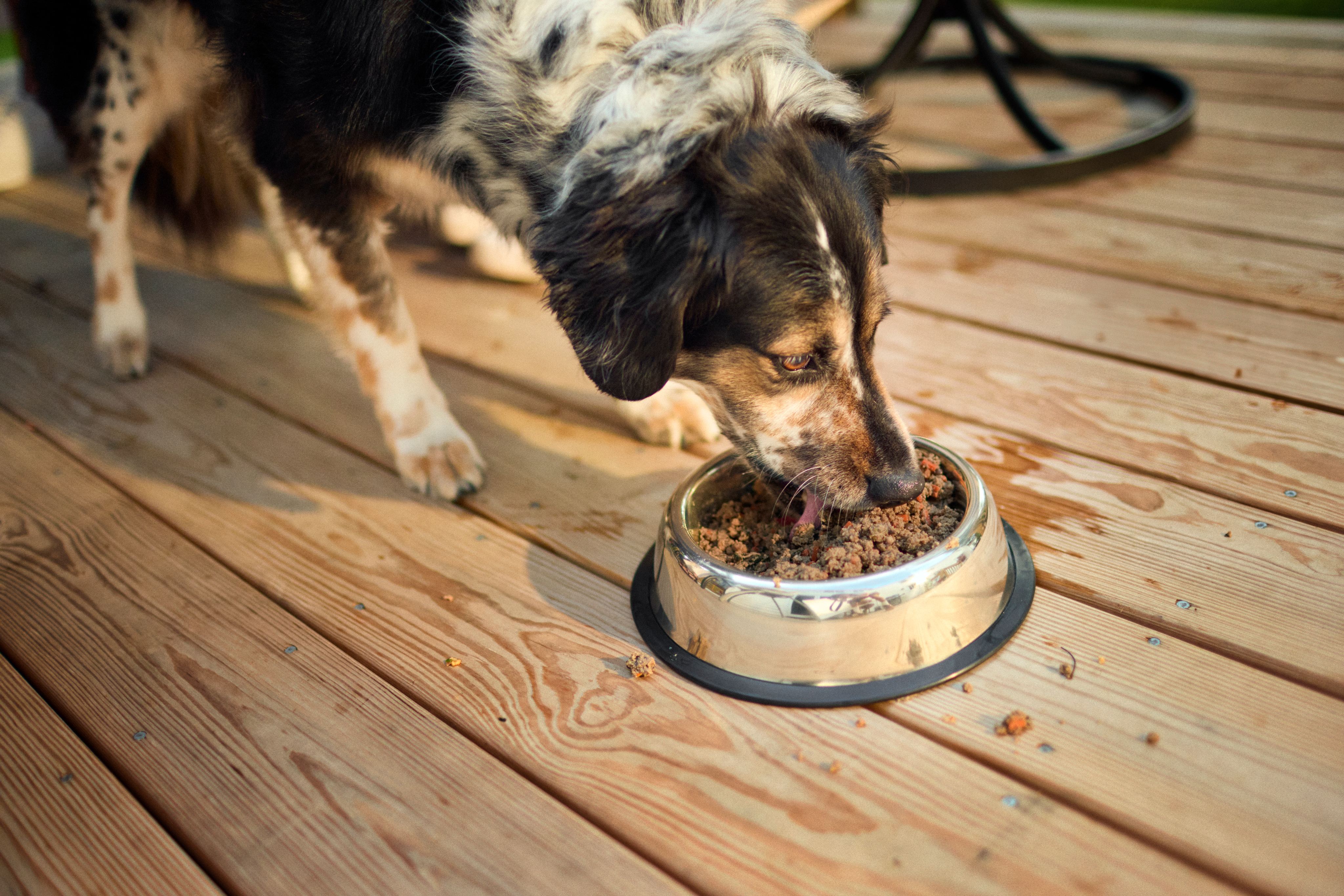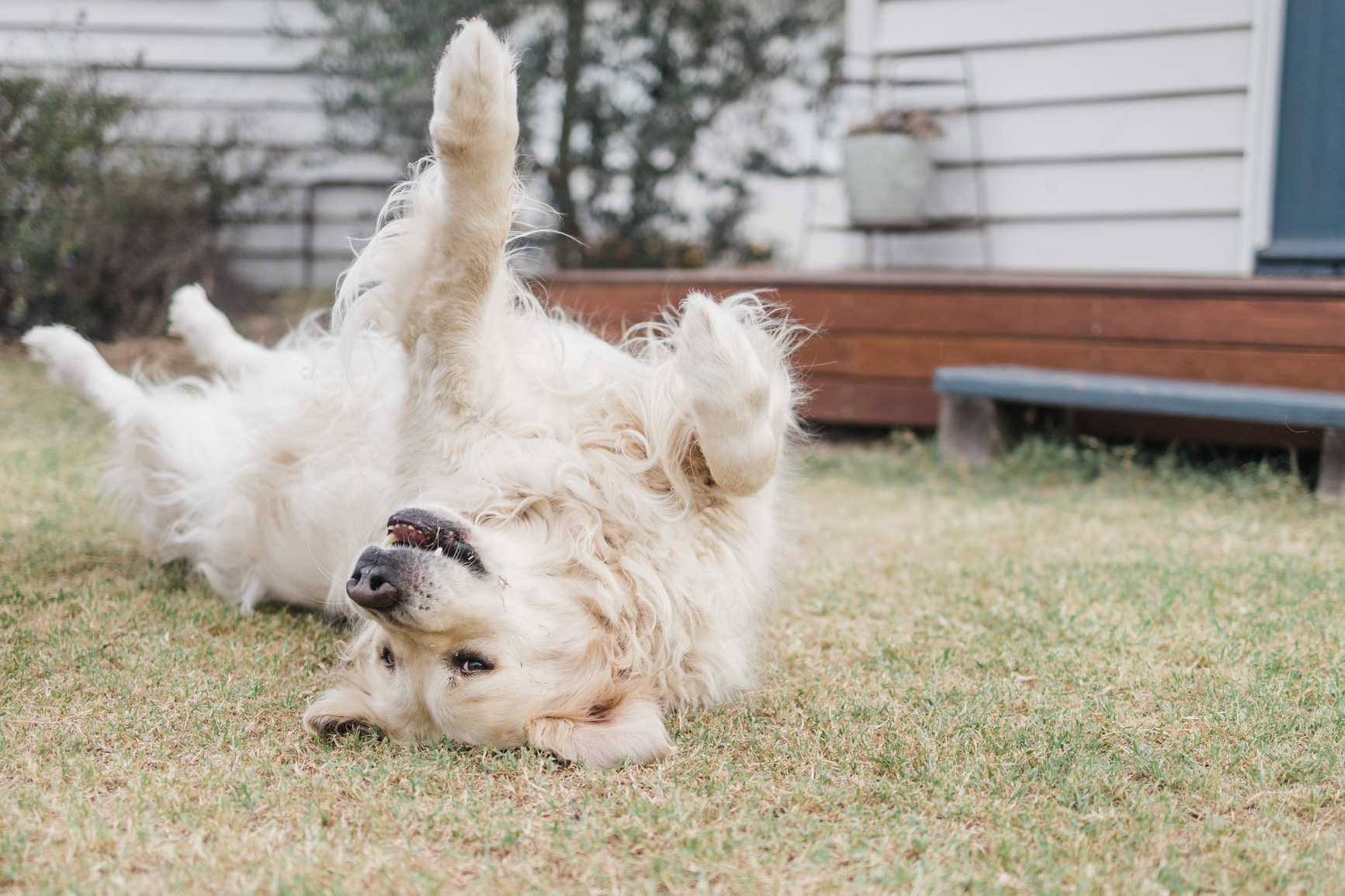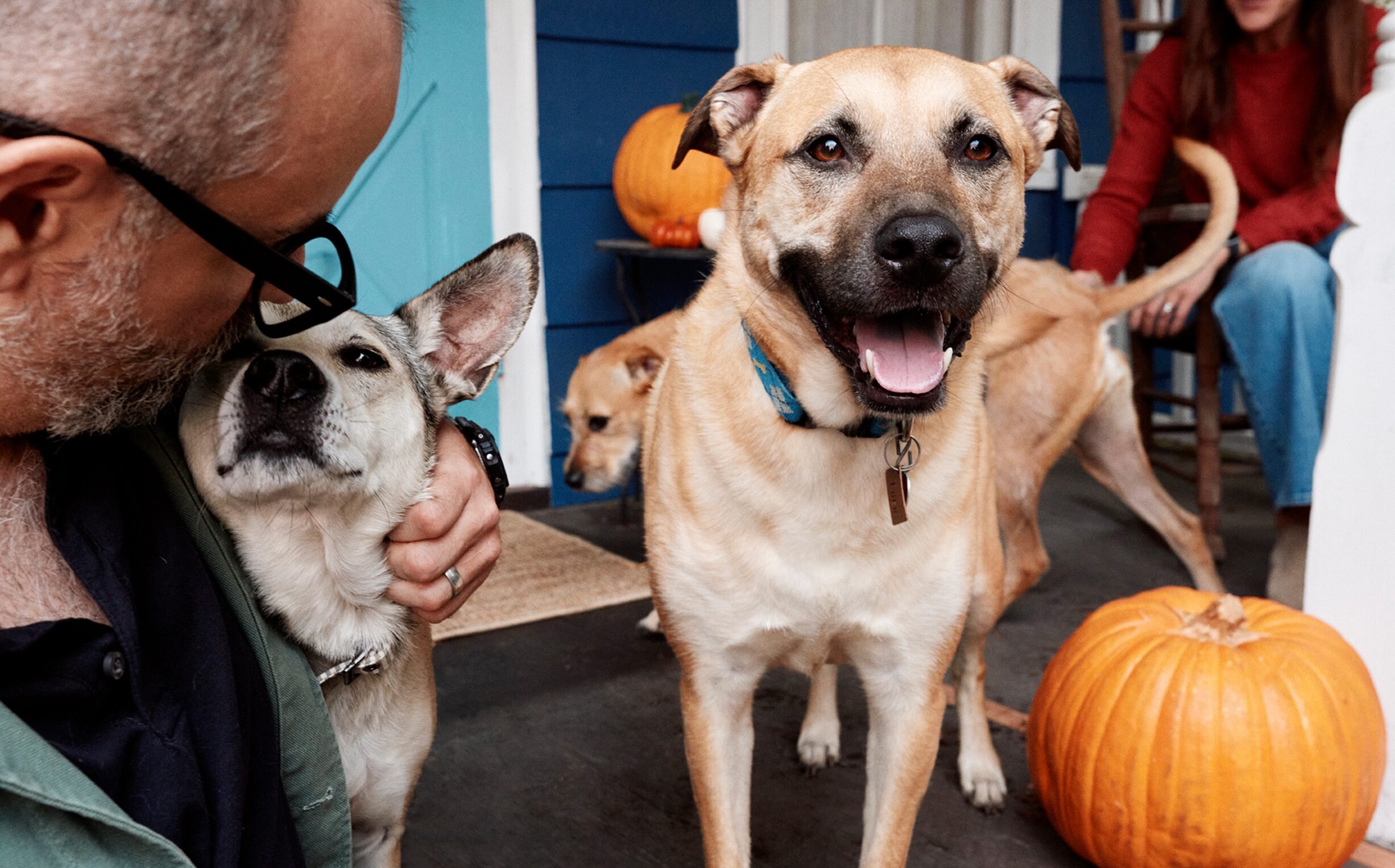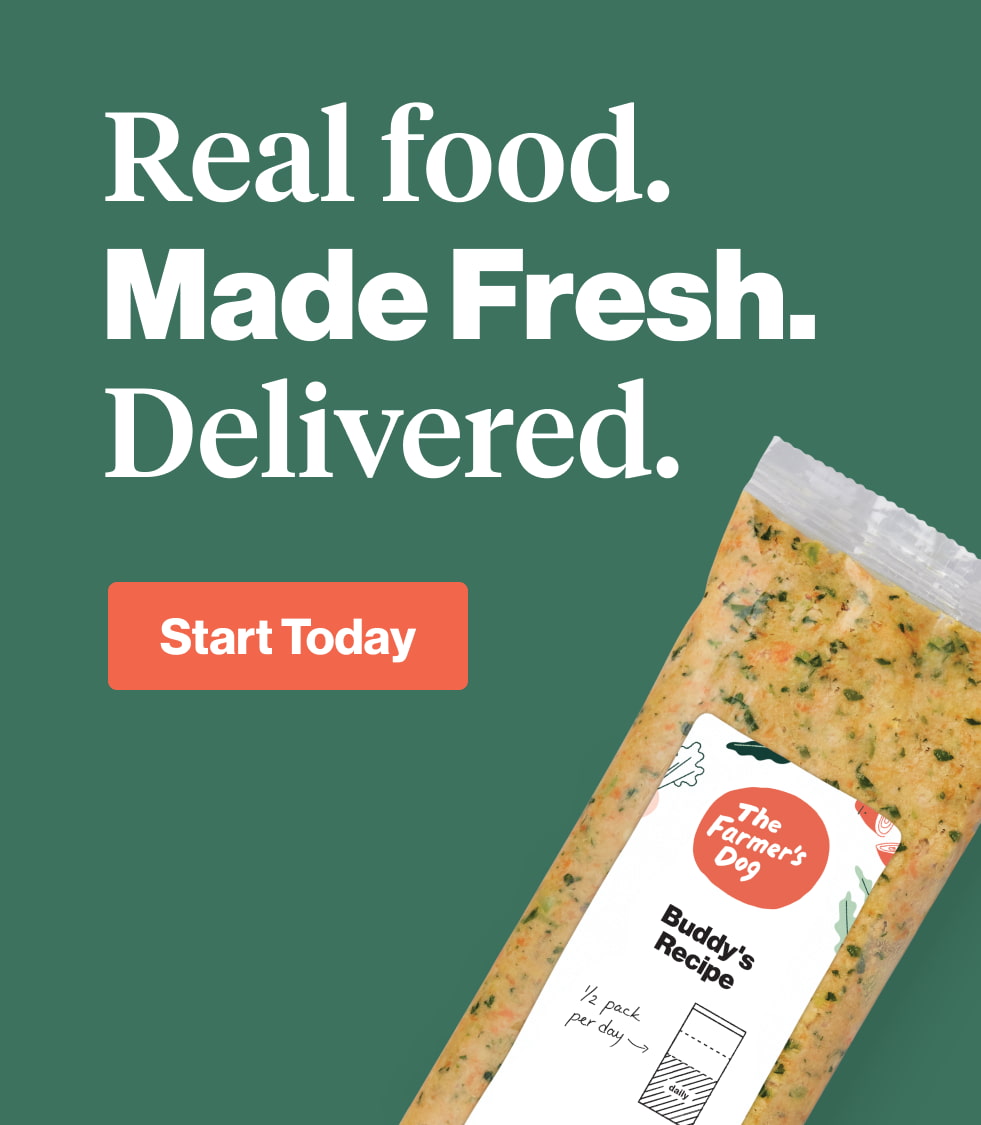In this article:
- Remember the 10% rule
- Can my dog eat Thanksgiving turkey?
- Can my dog eat gravy?
- Can my dog eat dinner rolls?
- Can my dog eat mashed potatoes?
- Can my dog eat candied yams and sweet potato casserole?
- Can my dog eat corn casserole?
- Can my dog eat green bean casserole?
- Can my dog eat roasted veggies?
- Can my dog eat stuffing?
- Can my dog eat cranberry sauce?
- Can my dog eat mac and cheese?
- Can my dog eat pumpkin pie?
- Can my dog eat pecan pie?
- Can my dog eat apple pie with ice cream?
When Thanksgiving rolls around, it’s hard not to get excited for turkey, stuffing, cranberry sauce, sharing a meal with family and friends… and maybe sitting in the corner with the dog to avoid tense conversations. And, for all their emotional labor, don’t dogs deserve a seat at the table—or even a plate of their own?
Because Thanksgiving foods tend to be rich—full of fats, spices, sugar, and other ingredients that range from slightly unhealthy to downright dangerous—sharing a seasonal plate with your four-legged housemate isn’t quite as easy as loading up a little of each dish and letting them have at it. Feeding fatty table scraps and other dog-inappropriate foods can cause or exacerbate inflammation, weight gain, and pancreatitis.
That doesn’t mean, however, that your dog can’t enjoy your family celebration.
First, keep in mind that extra playtime and a fun toy can be a great way to reward your dog and keep them busy on special days like this. But if you want to mark the occasion with some food-based excitement, we broke down what Thanksgiving foods your dog can and can’t eat, and how to give them their own feast (or at least a treat).
Remember the 10% rule
Treats and other extras should comprise no more than 10% of your dog’s diet, so feed even the healthiest extras in moderation. Your dog’s primary source of nutrition should always be a complete and balanced food.
“When you are trying to share your holiday meal with your pet, it’s always good to make the base meal their normal food and then add any little bit as a topper,” said Sam Bilko, DVM, Diplomate of the American College of Veterinary Emergency and Critical Care, a clinical assistant professor of emergency and critical care at the University of Wisconsin–Madison School of Veterinary Medicine.
Keep foods you know are dangerous to your dog, including alcohol and chocolate, out of reach.
Knowing what kind of stomach your dog has should also inform your choice about whether and how to indulge them. “Pet parents know their pet,” said Renee Schmid, DVM, DABT, Diplomate of the American Board of Veterinary Toxicology, director of veterinary medicine and senior veterinary toxicologist for the Pet Poison Helpline. If you know that your dog throws up from eating a little bit of anything other than their regular food and treats, she said, then forgo human food altogether.
And, if you see or suspect that your dog has eaten something they shouldn’t have—be it chocolate, garlic, onion, or the whole dang bird—call the vet, emergency veterinary hospital, or pet poison helpline right away. Keep an eye out for vomiting, diarrhea, and unusual behavior that can be signs of toxicity or gastrointestinal upset.
Can my dog eat Thanksgiving turkey?
Yes—but only plain and cooked…
Turkey is good for dogs: It’s rich in protein and other essential nutrients such as iron, phosphorus, and zinc, and it’s low in fat. It’s a key ingredient in one of our very own fresh recipes!
But Thanksgiving turkey is often prepared using huge amounts of salt and butter, as well as onion and garlic—the latter two of which are toxic to dogs. These ingredients can damage red blood cells, and must be avoided. The bird’s skin also contains tons of stomach-upsetting fat, so exercise caution in feeding your dog meat.
“Turkey skin, especially if deep fried, can [cause] stomach upset or pancreatitis,” said Dr. Schmid. All this fat “causes the pancreas to work overtime.”
She also entreated dog owners to keep all bones out of their dog’s reach. “If those pieces of bones happen to break off and splinter, they can cause damage to the intestinal tract,” she said. Swallowed bones, even if they remain whole, can obstruct the digestive tract.
This centerpiece’s drippings can also hold high concentrations of fat, garlic, and onion, said Dr. Bilko.
Both Dr. Schmid and Dr. Bilko suggested giving your dog a morsel of boneless, skinless white meat, sans drippings and gravy. White meat (like the breast) has less fat than dark meat (like the thigh or wing).
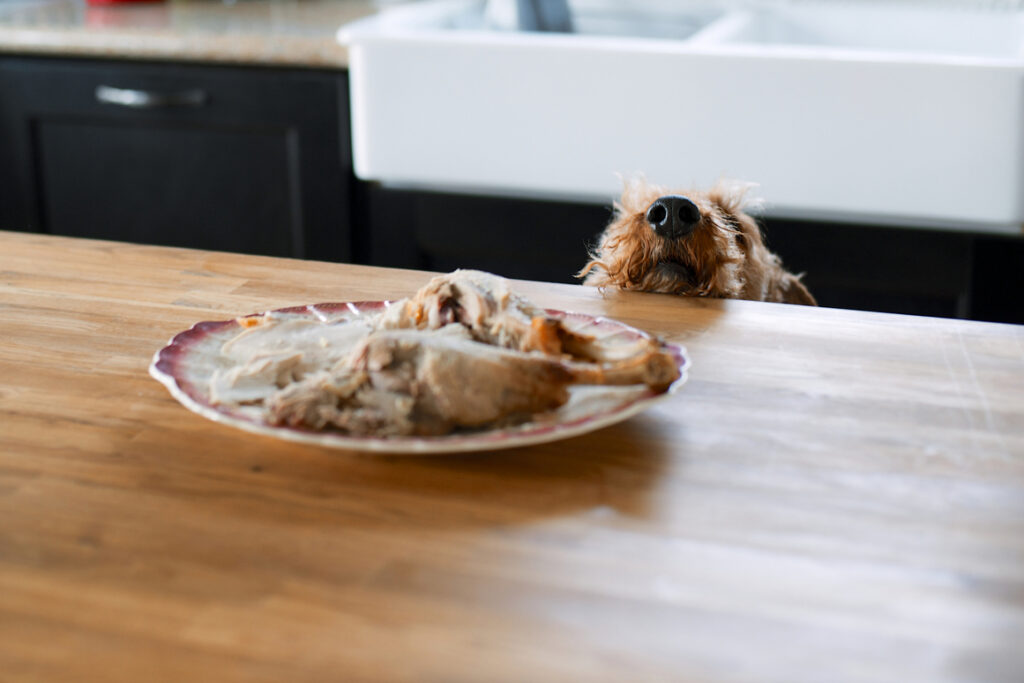
Can my dog eat gravy?
No.
There are as many different recipes for gravy as there are families celebrating the holidays, but most traditional gravy includes fat-laden pan drippings and salt. It’s a decadent extra whether jarred, from the packet, or made from scratch. And, in addition to fat and seasonings, gravy can contain toxic garlic and/or onion, which should be kept away from dogs.
Dr. Schmid says that gravy could cause “a stomach upset, depending on what it’s made with,” and that it’s best to err on the side of caution. Dr. Bilko also highlighted gravy’s high salt content, which can be unhealthy for your dog. While it’s safest to skip, if you do give your dog any gravy, make sure it’s free of garlic and onion, and that you feed a very small amount.
Feed this instead: Low-sodium chicken broth.
Your dog will be happier and healthier if their meal is topped with a bit of canine-appropriate low-sodium chicken broth. Dr. Schmid said she opts for chicken because beef tends to have more fat. Dr. Bilko said that, if you prepare homemade broth or stock, it’s best to strain bones, skin, and other obstructive or fatty bits from the liquid.
Another option is bone broth, made by simmering bones and connective tissue for a long, long time. Prepared without added seasoning or garlic, it’s a safe and healthy addition to your dog’s diet.
Can my dog eat dinner rolls?
Yes, once they’ve been baked.
Bread dough contains yeast, which makes the dough rise. While bread dough may not seem like a tasty treat to us, some dogs will eat anything, and you’ll want to actively keep your dog away from rising dough.
Yeast in unbaked dough poses a toxic threat, Dr. Schmid said. “That warm, moist environment of the stomach allows that yeast to ferment,” she said. “Then it produces gases, which cause [bloating].” In other words, the dough continues to rise inside a dog, potentially causing an obstruction. She added that as the yeast ferments in the gut it produces ethanol, creating the risk of alcohol poisoning.
If you’re baking any breads with raisins, keep them safely out of your dog’s reach, too. Grapes and raisins are extremely dangerous to dogs, and even very small quantities of them can be fatal.
Feed this instead: A bit of plain, baked dinner roll is safe.
Can my dog eat mashed potatoes?
Only in the smallest amounts—before adding dairy and seasonings.
Most mashed potatoes served at Thanksgiving are loaded with butter, milk, cream, salt, perhaps garlic, and other seasonings. These make the dish too decadent, and possibly dangerous, for dogs.
And, while potatoes contain plenty of nutrients—like vitamins C and B6, folate, and potassium—they are high in starch, which can negatively impact blood sugar over the long term. And always avoid raw potatoes, as well as the green parts of the potato’s skin, as they contain a toxic component called solanine.
Feed this instead: Plain, cooked potato
If you want to share a bit of potato in honor of this festive occasion, make sure it’s boiled, mashed, and served plain. Separate some mash for your dog before you load in the butter, salt, or other flavorings.
“Mash the potatoes [and] set some aside before you add the milk and the butter,” said Dr. Bilko. “Maybe a scoop on top of their dinner.”
And keep the portion extra small because of the high starch.
Can my dog eat candied yams and sweet potato casserole?
No.
Many of us encounter sweet potatoes on the Thanksgiving table in the form of sweet potato casserole mixed with brown sugar, butter, and nutmeg, topped with marshmallows. Only one of these things is good for dogs, and it’s the sweet potato. Sugar isn’t toxic to dogs per se, but it can contribute to dental disease, acute pancreatitis, diabetes, obesity, and inflammation—and can also cause stomach upset.
“The rest of the stuff that we add on top—the nuts, the marshmallows, the brown sugar, the butter—that’s all going to cause GI upset,” Dr. Bilko said.
If your candied yams or sweet potato casserole use a sugar substitute like xylitol, definitely keep that away from dogs, Dr. Schmid said. Xylitol can cause drops in blood sugar, liver damage, and even death in dogs. If you suspect yours has eaten any of it, that calls for an immediate trip to the vet.
And avoid nutmeg entirely; it contains a toxin called myristicin, which is dangerous for dogs. While it typically takes fairly large amounts to cause serious ill effects—signs of toxicity include hallucinations, dry mouth, increased heart rate, seizures, and worse—you should steer clear to be safe.
Feed this instead: Plain, cooked sweet potato.
Sweet potatoes are great for dogs’ digestive health, high in potassium, and a low-fat, high-reward treat.
“They can have a little bit of a plain sweet potato,” Dr. Bilko said. “That’s high in fiber.”
If you’re fixing a plate for your dog, set aside some plain sweet potato, either canned or boiled. Mash up a small amount and serve solo or as a food topper.
Can my dog eat corn casserole?
No.
Somewhere between bread and pudding, corn casserole may be chock full of sour cream, cream cheese, cheese, and/or butter—really just a wonderfully fatty assortment of dairy products, all of which are bad for your dog.
It’s “not a poison or a toxic concern, but certainly enough to cause stomach upset,” as well as pancreatitis, Dr. Schmid said. “That’s going to be a hospital stay [or] doctor visit.”
Feed this instead: Just plain corn.
“Set some of the corn itself off to the side,” Dr. Schmid recommended. Plain corn, that is.
And “definitely don’t give your dog the cob,” Dr. Bilko added. “I see quite a lot of obstructions off of corn cobs all times of year.”
Can my dog eat green bean casserole?
No.
A timeless classic, green bean casserole is a family favorite because it takes a delicious, healthy vegetable and adds the likes of butter and salt, fried onions (which are toxic to dogs), and even cream-of-mushroom soup. Your dog shouldn’t eat any of this, so save that unctuous treat for your human family.
Feed this instead: Plain green beans.
Green beans, themselves low in calories and high in nutrients, are great for dogs. You can feed them raw, steamed, or boiled—just be sure to avoid canned beans that have added salt.
“You can even give [green beans] to [your dog] after you’ve washed and prepped them, but before you cook them,” Dr. Bilko said. “Or if you’re cooking them, they should be separate from the [other ingredients].”
Trim the ends and cut into small pieces to reduce the chance of choking.
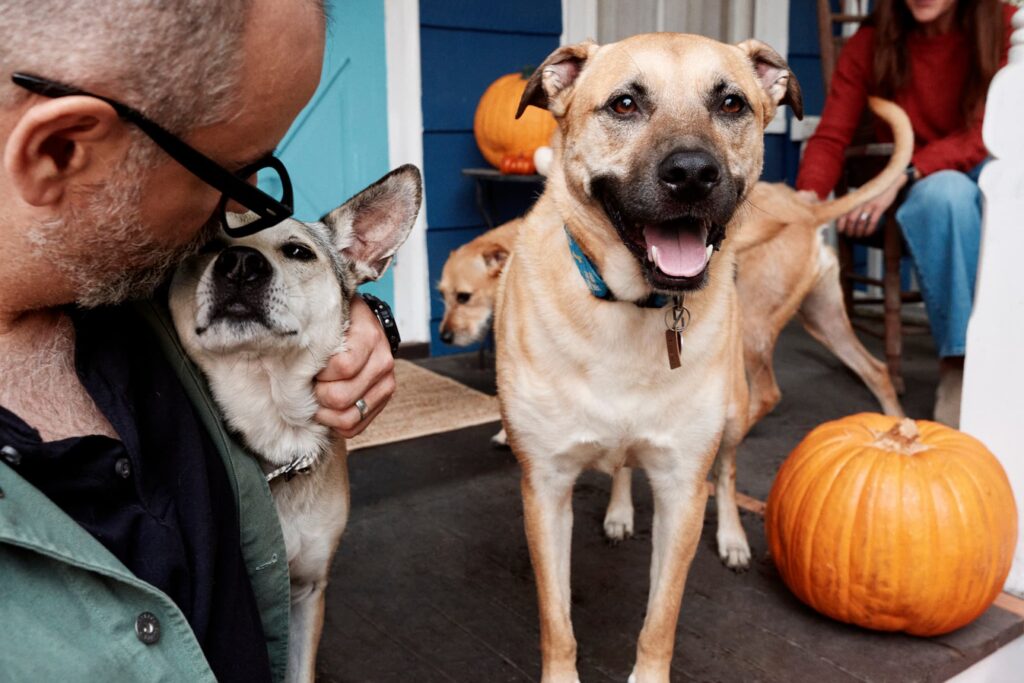
Can my dog eat roasted veggies?
Yes, but…
Glazed carrots, roasted Brussels sprouts, and oven-cooked broccoli make a Thanksgiving table all the more colorful. Delicious for us, these oil-sopped, salted veggies—which may even be engulfed in bacon—are not for your dog. Set aside unseasoned roasted veggies for your pooch.
Dr. Bilko praised carrots as particularly good for dogs “just as a healthy day-to-day snack, even, whether they’re raw or roasted.” As for Brussels sprouts, broccoli, and cauliflower, she said, “I would do in less quantity, only because they can cause flatulence and a little bit of GI upset if you eat too many.” She also warned dog owners to cut veggies into bite-sized pieces so they’re not choking hazards.
These veggies, washed, cut up, unseasoned, and roasted, steamed, or boiled, are good in moderation for your dog.
Set aside a sprout or two for your dog. Boil or steam them, cut them into pieces, and add them to their Thanksgiving dinner.
Can my dog eat stuffing?
No.
Whether boxed or homemade, stuffing is full of salt and fat—two things that can upset your dog’s stomach and cause diarrhea or vomiting. Many stuffing recipes also include onions, garlic, and other seasonings that are toxic to dogs.
Feed this instead: Stick to single ingredients that have not yet commingled with potentially toxic add-ins.
Can my dog eat cranberry sauce?
No.
While plain cranberries are fine to give dogs sparingly, cranberry sauce is basically cranberry-flavored sugar, and too much can cause gastrointestinal upset in the form of vomiting and diarrhea. Further, some recipes, especially for homemade cranberry sauce, include nutmeg, mace, and other spices that are dangerous for dogs.
“It’s not the cranberry itself that’s so much the problem as all the additives that go into [the sauce],” Dr. Bilko said.
What’s more, Dr. Schmid reaffirmed that if you have low-sugar or sugar-free cranberry sauce that uses xylitol or another sugar substitute, you must keep it away from your dog—for their own good. Again, xylitol is toxic to dogs and it’s a medical emergency if they eat it.
Feed this instead: If your dog likes the tart taste, feed a few fresh or dried cranberries. Crush them to make them easier to eat and reduce choking hazard. Stay away from cranberry sauce and cranberry juices, which can contain added sugars and other ingredients. And avoid Craisins.
Or, feed a few blueberries! They’re loaded with vitamins and minerals, and known for their high levels of health-boosting antioxidants and phytochemicals.
Can my dog eat mac and cheese?
No.
Keep the mac and cheese away from your dog. Like so many other Thanksgiving sides, it’s likely full of butter, spices, salt, and other additives, including dreaded onion or garlic powder.
Moreover, “cheese is high in fat, so try to stay away from that,” Dr. Bilko said.
Feed this instead: If you’re tempted to honor the special occasion by giving your dog an extra-special snack, give them a small bit of plain, cooked macaroni.
“Pasta without cheese is okay,” Dr. Bilko said. “It’s a low-calorie snack, so a little topper on their food should probably be okay.” Make that pasta without cheese, butter, sauce, or anything else.
Can my dog eat pumpkin pie?
No.
Pumpkin pie has far too much sugar and fat, and many pumpkin pie recipes have nutmeg, which can be toxic to dogs in large quantities. And low-sugar or sugar-free pumpkin pie will often contain sugar substitutes, which are hazardous to dogs.
Feed this instead: Just pumpkin or plain pumpkin puree.
You can give your dog pumpkin or pumpkin puree, which is a healthy, popular treat that’s packed with fiber. Just make sure you give them either canned while you’re pie-prepping or plain boiled and mashed pumpkin—they’ll be sure to love it. And never give them a pumpkin product with any added ingredients.
Can my dog eat pecan pie?
No.
“Pecan pie is, I’m pretty sure, all sugar—so no pecan pie,” Dr. Bilko said. She added that “nuts in general are very high in fat,” so she tries to stay away from nuts for dogs.
And ditto on the low-sugar and sugar-free risk.
Feed this instead: Just stick with treats you already know are good for them.
Can my dog eat apple pie with ice cream?
No.
Sweet, spiced apple pie with a hefty scoop of rich, vanilla ice cream epitomizes fall for some. But this is a treat best kept to yourself. The many spices that make apple pie so delectable can irritate your dog’s stomach. It also bears repeating that toxic-to-dogs sugar substitutes may show up in some apple pies.
Ice cream, thick with dairy and sugar, might also provoke vomiting or diarrhea.
Feed this instead: Offer up some small apple slices during pie prep, Dr. Bilko suggested. And keep the core out of reach, as it’s a choking hazard.
